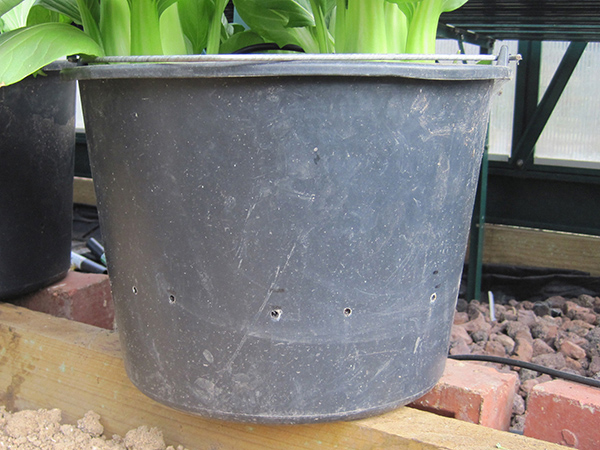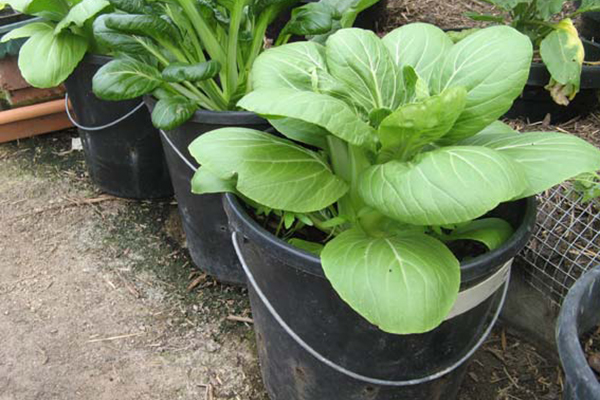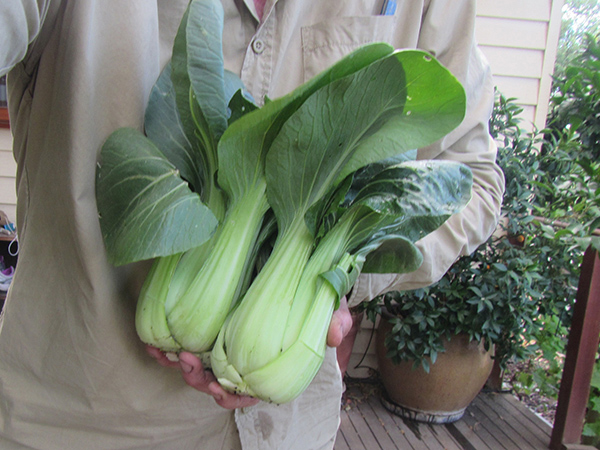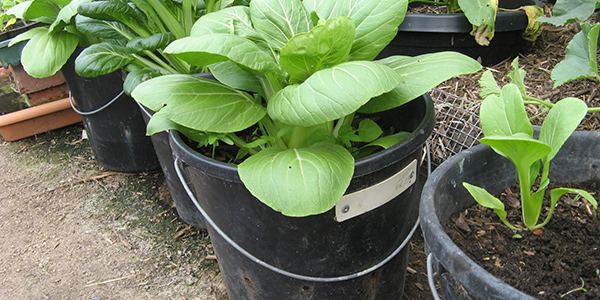Wet pots are designed to grow plants that thrive in boggy conditions. They are not suitable for growing vegetables that need good drainage.
A wet pot is a watertight container that has a set of small holes drilled in it at about 1/3 of the way up its side for drainage. Basically it works like a self-watering pot but with the reservoir filled with sodden soil instead of water. The reservoir is also much larger and closer to the top than a self-watering pot’s reservoir. As the holes are so small the drainage is poor, the effect of this larger reservoir and poor drainage is to keep the soil very wet, which is ideal for growing Asian vegetables such as Pak Choi, Mizuna and Tatsoi. When grown in soil that is constantly wet these vegetables are far less likely to bolt (go to seed).
Any watertight container will do but I use standard 10 litre buckets or 14 litre builders’ buckets. These buckets are large enough to hold sufficient water to meet a plant’s needs for two or three days but small enough to be moved easily. Using buckets has the added advantage of making them even easier to move around, though it is best to avoid buckets with plastic handles as they break easily.
TAKE A WATERTIGHT CONTAINER (A BUCKET IS IDEAL), MEASURE TO A POINT APPROXIMATELY 1/3 OF THE WAY UP ITS SIDE AND MARK THE POINT WITH A PENCIL
REPEAT THE PROCESS SEVERAL TIMES AROUND THE SIDE
DRILL SMALL HOLES AT REGULAR INTERVALS AROUND THE CONTAINER USING THE PENCIL MARKS AS A GUIDELINE
The holes should only be about 3 to 5 mm large, which is large enough to allow excess water to drain away but small enough so soil is not washed out the holes in large amounts. As the pot is designed for water loving plants the holes are only there to stop the container from filling with water. They are not there to create good drainage.FILL THE CONTAINER WITH COMPOST OR SOIL, PLANT SUITABLE SEEDLINGS AND WATER IN
You can also add some animal manure to the base. How many seedlings can be planted will depend on the size of the container and type of vegetable. I usually plant two Pak Choi seedlings in a bucket and three seedlings in a builders bucket.
If you are sowing seeds then spread a thin layer of seed raising mix over the top of the soil and plant your seeds into that.IF THE BUCKET IS SITTING ON A SURFACE THAT YOU DO NOT WANT TO BECOME WET THEN PLACE A SAUCER UNDERNEATH IT TO CATCH ANY OVERFLOW FROM THE DRAINAGE HOLES
Note that these instructions should only be seen as a rough guideline. Feel free to experiment with different sizes and hole heights etc..

Cutaway illustration showing how wet pots work.

Detail of drainage holes in a wet pot made from a 14 litre builders' bucket.

Pak Choi (foreground) and Tatsoi(centre) in wet pots made from standard buckets. Black buckets are ideal as they are more resistant to UV sunlight (the plastic takes longer to break down) and absorb the heat of the sun more readily, which means the soil in the bucket will be warmer.

Mature Green Pak Choi plants that were grown in a wet pot.
ADVANTAGES SUMMARY
ADVANTAGES
- Ideal for vegetables that like wet soil.
- Cheap and easy to make.
-
Very portable.
DISADVANTAGES SUMMARY
DISADVANTAGES
- Not good for vegetables that like good drainage.




